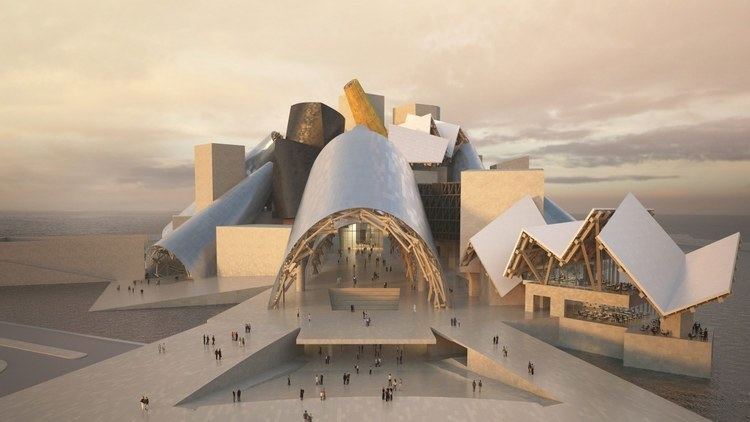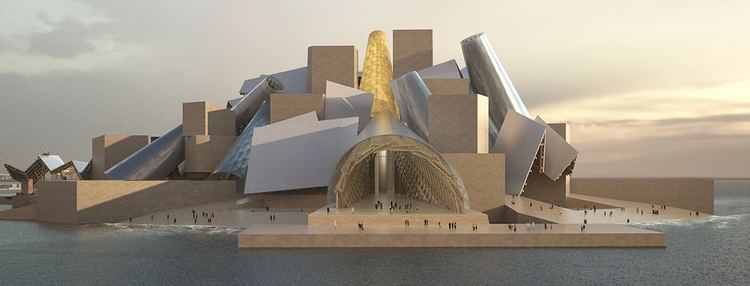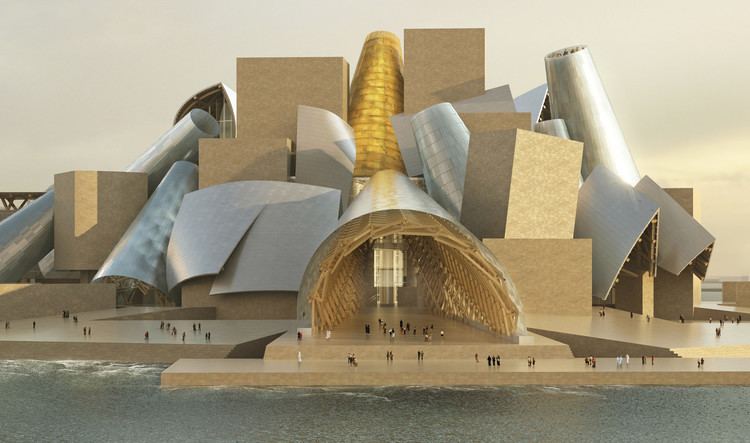Architectural style Deconstructivism | ||
 | ||
Cost US$200 million (estimated) Similar 8 Spruce Street, Gehry Residence, Gehry Tower, Santa Monica Place, Walt Disney Concert | ||
Guggenheim abu dhabi saadiyat
The Guggenheim Abu Dhabi is a planned museum, to be located in Abu Dhabi, UAE. On July 8, 2006, the city of Abu Dhabi, capital of the United Arab Emirates, announced it had signed an agreement with the Solomon R. Guggenheim Foundation in New York City to build a 30,000-square-metre (320,000 sq ft) Guggenheim Museum on Saadiyat Island. Upon completion, it is planned to be the largest of the Guggenheim museums. Architect Frank Gehry is designing the building. Work on the site began in 2011 but was soon suspended. As of 2017, no completion date is available. The museum collection is planned to reflect Islamic and middle-eastern culture.
Contents
- Guggenheim abu dhabi saadiyat
- Location
- Contract
- Design and construction
- Artwork
- Human rights controversy
- References

The museum is part of a larger complex of arts and cultural institutions that is being built on Saadiyat Island intended to appeal to international tourists.

Location

The museum will be located on Saadiyat Island, just offshore of the city of Abu Dhabi. The island's Cultural District will house the largest cluster of world-class cultural assets in Abu Dhabi. The building is part of a massive project to "create an exhibition space intended to turn this once-sleepy desert city along the Persian Gulf into an international arts capital and tourist destination." Former Guggenheim director Thomas Krens indicated that "The Middle East is one of the world's most important emerging regions in terms of contemporary culture."

The facilities planned for the island are to include: the Zayed National Museum, designed by United Kingdom-based construction company Foster and Partners under the direction of Lord Norman Foster; the Louvre Abu Dhabi art museum designed by Jean Nouvel; a performing arts centre designed by Zaha Hadid; a New York University campus, a maritime museum with concept design by Tadao Ando and a number of arts pavilions.
Contract

The Guggenheim stated in 2008 that "Abu Dhabi's Tourism Development & Investment Company ... will own the museum", while "[t]he Guggenheim Foundation will establish and manage" its program. William Mack, Chair of the Solomon R. Guggenheim Foundation, said: "It is with a keen sense of historical precedent and with an abiding commitment to cultural exchange as a bridge to international understanding that the foundation enters into this agreement to establish a Guggenheim museum in Abu Dhabi."

Abu Dhabi's crown prince, Mohammed bin Zayed Al Nahyan, indicated that the "signing represents the determination of the Abu Dhabi Government to create a world-class cultural destination for its residents and visitors.
Design and construction
The Guggenheim museum's design is by architect Frank Gehry. The lighting was designed by L'Observatoire International. Surrounded on three sides by the Persian Gulf, the site also acts as a manmade breakwater that protects the island’s northern beaches. Gehry noted, "The site itself, virtually on the water or close to the water on all sides, in a desert landscape with the beautiful sea and the light quality of the place suggested some of the direction."
The museum is planned, at 320,000 square feet (30,000 m2), to be the Solomon R. Guggenheim Foundation's largest facility. It is designed to accommodate approximately 130,000 square feet (12,000 m2) of exhibition space. Gehry's design features exhibition galleries, education and research space, a conservation laboratory, a center for contemporary Arab, Islamic and Middle Eastern culture, and a center for "art and technology". Inspired by traditional middle-eastern covered courtyards and wind towers, used to cool structures exposed to the desert sun, the museum's clusters of horizontal and vertical galleries of various sizes are connected by catwalks and planned around a central, covered courtyard, incorporating natural features intended to maximize the energy efficiency of the building. The largest galleries will offer a grand scale for the display of large contemporary art installations. Parts of the building will be four stories tall with galleries stacked atop each other. The museum is intended to be a centerpiece in the island's plan for contemporary art and culture".
In 2011, the museum began construction on a peninsula at the northwestern tip of Saadiyat Island adjacent to Abu Dhabi, but after some work on the foundation, construction was suspended the same year. The completion date was first pushed back from 2011 to 2013 then to 2015, after the emirate cancelled contracts with concrete suppliers, and again to 2017 "amid more difficult economic times". Continued progress awaits the approval of construction applications and contracts by the Tourism Development & Investment Company (TDIC). As of 2016, no progress had been made on construction, and the Guggenheim Foundation confirmed that "TDIC has not yet awarded a contract."
Artwork
The museum is intended to form its own major collection of modern contemporary art that are expected to focus on Middle-Eastern works. It will also display special exhibitions from the foundation's main collection. All works to go on display at the museum will "respect Abu Dhabi's culture and national and Islamic heritage," the foundation said in a statement. "Our objective is not to be confrontational, but to be engaged in a cultural exchange," said Thomas Krens when asked how the boldness of contemporary art can be reconciled with conservative Muslim values. "The Guggenheim implicitly regards all contemporary cultures and their traditions as potential partners in the field of aesthetic discourse - we are both respectful of difference and excited by it," he said. "We also believe that the Middle East is one of the world's most important emerging regions in terms of contemporary culture."
As of 2014, Guggenheim curators have been collecting an international representation of art for the past five years. The museum plans to show a preview of these works as "Seeing Through Light: Selections from the Guggenheim Abu Dhabi Collection" at the island's visitor's center at Saadiyat from November 2014 through January 2015.
Human rights controversy
Over 130 international artists urged a boycott of the new Guggenheim museum (as well as Louvre Abu Dhabi), citing reports, since 2009, of abuses of foreign construction workers on Saadiyat Island, including the arbitrary withholding of wages, unsafe working conditions and failure of companies to pay or reimburse the steep recruitment fees being charged to laborers. According to Architectural Record, Abu Dhabi has comprehensive labor laws to protect the workers, but they are not conscientiously implemented or enforced. In 2010, the Guggenheim foundation placed on its website a joint statement with TDIC recognizing the following workers' rights issues, among others: health and safety of the workers; their access to their passports and other documents that the employers have been retaining to guaranty that they stay on the job; using a general contractor that agrees to obey the labor laws; maintaining an independent site monitor; and ending the system that has been generally used in the Persian Gulf region of requiring workers to reimburse recruitment fees.
In December 2013, The Observer reported that conditions for the workers at the Louvre and New York University construction sites on Saadiyat amount to "modern-day slavery". In April 2014, the Guggenheim's Director, Richard Armstrong, said that he believed that living conditions for the workers at the Louvre project were now good and that "many fewer" of them were having their passports confiscated. He stated that the main issue then remaining was the recruitment fees charged to workers by agents who recruit them. Asked if the Guggenheim would refuse to proceed with the construction unless these issues were solved, he answered, "we have faith that there will be progress."
In September 2014, the Guggenheim's architect, Gehry, commented that working with the Abu Dhabi officials to implement the law to improve the labor conditions at the museum's site is "a moral responsibility." He is encouraging the TDIC to build additional worker housing and proposes that the contractor cover the cost of the recruitment fees. In 2012, TDIC engaged PricewaterhouseCoopers as an independent monitor, which issues reports every quarter. TDIC solicited bids by contractors in August 2014 and as of September 2014 was expected to hire a general contractor soon. Labor lawyer Scott Horton told Architectural Record that he hopes the Guggenheim project will influence the treatment of workers on other Saadiyat sites and will "serve as a model for doing things right."
